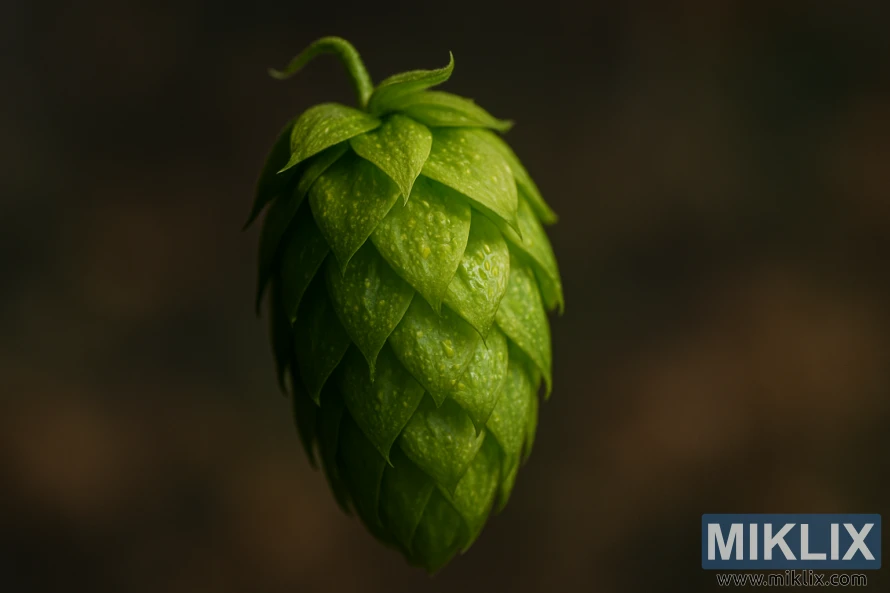Image: Singular Aramis Hop Cone Close-Up
Published: September 25, 2025 at 7:45:46 PM UTC
A vivid close-up of a single Aramis hop cone, showing its layered green bracts, golden lupulin speckles, and delicate resinous texture.
The image portrays a singular Aramis hops cone in a striking close-up, suspended against a softly blurred, earthy-toned background. The overall composition is minimalistic yet visually rich, with every aspect carefully orchestrated to draw attention to the hop cone’s intricate structure and vibrant coloration. The shallow depth of field isolates the cone completely from its surroundings, transforming it into a captivating botanical specimen and highlighting its natural elegance.
The hop cone itself appears almost luminous, rendered in vivid shades of green that transition subtly from deeper, foresty tones at the lower bracts to lighter, more yellow-green highlights at the upper layers. Each individual bract is distinct, overlapping with geometric precision in a tight spiral that tapers toward the base, giving the cone a compact teardrop-like form. The bracts are slightly translucent at their thin edges, allowing the soft directional lighting to pass through and create glowing margins that accentuate their delicate structure. This interplay of light and shadow adds a three-dimensional sculptural quality to the cone, enhancing the viewer’s sense of its physical presence.
Upon closer inspection, the fine textural details of the bracts come into sharp relief. Their surfaces are subtly dimpled and veined, with tiny resinous lupulin glands visible as minute golden speckles scattered across the green tissue. These glands glisten faintly, catching the light in pinpoint highlights that hint at the sticky, aromatic oils contained within. This visual suggestion of lupulin immediately evokes the characteristic essence of Aramis hops—an aromatic profile known for its nuanced blend of citrus brightness, gentle pine notes, and a whisper of earthy spice. The photograph seems to capture not just the physical form of the cone but the sensory anticipation of its aroma, as though its fragrant potential is suspended in the air around it.
The lighting is soft yet deliberately directional, coming from an off-frame source that illuminates the cone’s left side while letting the opposite side fall into gentle shadow. This lighting scheme enhances the textural depth of the bracts, revealing their subtle curvature and the layered architecture of the cone. The shadows are not harsh or high-contrast but diffuse and velvety, maintaining a warm, natural feel. This approach to lighting imbues the image with a contemplative and almost reverential tone, emphasizing the artisanal care associated with selecting and handling specialty hops like Aramis.
The background is rendered in a creamy bokeh blur, its colors a muted blend of warm browns and soft olive greens that suggest wood or earth but remain abstract enough not to draw focus. This out-of-focus backdrop provides a serene, neutral canvas that enhances the vibrancy of the hop cone’s green hues without introducing visual clutter. The absence of any competing elements ensures that the viewer’s attention remains fixed solely on the subject, amplifying its significance within the frame.
Overall, the image encapsulates the essence of Aramis hops as a singular, precious ingredient in the craft of brewing. By isolating the cone in such intimate detail and pairing it with subdued surroundings, the photograph elevates it beyond a simple botanical object, presenting it instead as a symbol of the complexity, care, and sensory richness that define aroma-driven beer styles. It invites the viewer to appreciate not only the visual intricacy of the hop cone but also the aromatic promise contained within its delicate, resin-laden layers.
The image is related to: Hops in Beer Brewing: Aramis

